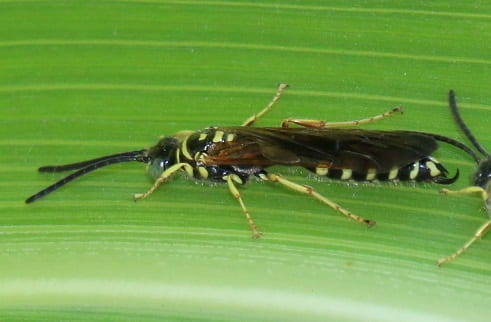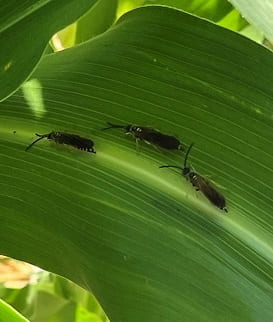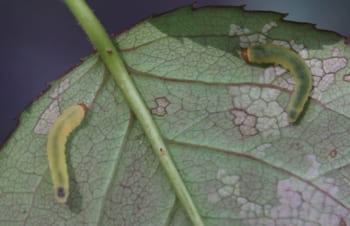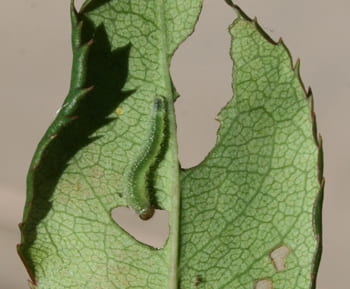–by Raymond Cloyd, Horticultural Entomologist
Japanese beetle, Popilla japonica, adults are present throughout Kansas feeding on many plants in landscapes and gardens including: roses (Rosa spp), littleleaf linden (Tilia cordata), oak (Quercus spp.), Virginia creeper (Parthenocissus quinquefolia), crabapple (Malus spp.), and grape (Vitis vinifera). The plant protection strategies that need to be implemented to manage Japanese beetle adult populations are limited and have been for many years. The primary stra tegy involves spraying contact insecticides to kill adults, which will reduce plant damage.
Japanese beetle adults are 3/8 to 1/2 of an inch long, metallic green with coppery-brown wing covers, and approximately 14 tufts of white hair along the edge of the abdomen (Figure 1).
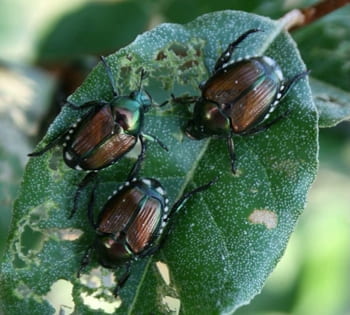
Figure 1. Japanese Beetle Adults Feeding On Leaf (Raymond Cloyd, KSU)
Japanese beetle adults live up to 45 days feeding on plants over a four-to-six-week period. Adults feed on many horticultural plants including: trees, shrubs, vines, herbaceous annual and perennials, vegetables, fruits, an d grapes (Figure 2).
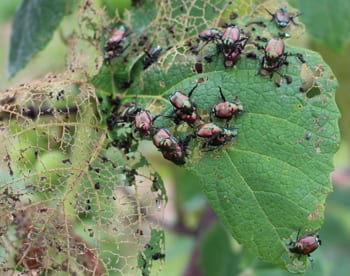
Figure 2. Japanese Beetle Adults Feeding On Grape Leaf (Raymond Cloyd, KSU)
Japanese beetle adults produce aggregation pheromones that attract males and females to the same feeding location, which enhances mating (Figure 3).

Figure 3. Japanese Beetle Adult Males And Females Mating (Raymond Cloyd, KSU)
Adults can fly up to five miles to locate a host plant; however, adults tend to only fly short distances to feed and for females to lay eggs.
Japanese beetle adults feed through the upper leaf surface (epidermis) and leaf center (mesophyll), leaving the lower epidermis intact. Adults, in general, do not feed on tissue between leaf veins. Consequently, feeding on tissue between the leaf veins causes the lace-like or skeletonized appearance (Figure 4).
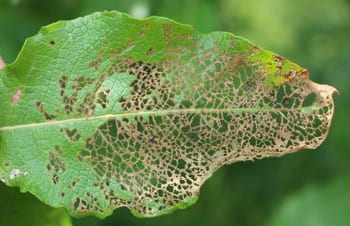
Figure 4. Japanese Beetle Adult Feeding Damage On Leaf (Raymond Cloyd, KSU)
Adults are primarily active on warm days, feeding on plants exposed to full sun, which may be why roses are a susceptible host plant because roses require at least six hours of direct sunlight to flower. Japanese beetle adults start feeding at the top of plants, migrating downward as food sources are depleted. Japanese beetle adults will also feed on flowers (Figure 5),

Figure 5. Japanese Beetle Adults Feeding On Rose Flower (Raymond Cloyd, KSU)
chewing holes in flower buds, which prevents flowers from opening or causes petals to fall prematurely.
Managing Japanese beetle adult populations involves implementing a variety of plant protection strategies, including: cultural, physical, and applying insecticides. Cultural control includes proper irrigation, fertility, mulching, and pruning that are important in minimizing plant stress, which may decrease susceptibility to Japanese beetle adult feeding. Furthermore, removing weeds attractive to Japanese beetle adults such as smartweed, Polygonum spp., may help to alleviate infestations. Physical control such as hand removing or collecting Japanese beetle adults before populations are extensive may minimize plant damage. The best time to remove or collect adults is in the morning when ambient air temperatures are typically cooler. Adults can be collected by placing a wide-mouthed jar or bucket containing rubbing alcohol (70% isopropyl alcohol) or soapy water underneath each adult, and then touching them. Adults that are disturbed fold their legs perpendicular to the body, fall into the liquid, and are subsequently killed. The procedure may reduce plant damage when conducted daily or every-other-day, for up to four weeks.
The use of Japanese beetle traps in landscapes or gardens is not recommended since the floral lure and synthetically derived sex pheromone (Figure 6)
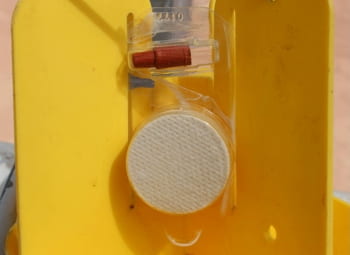
Figure 6. Floral Food Lure (Bottom) And Synthetically-Derived Sex Pheromone (Top) Associated With Japanese Beetle Trap (Raymond Cloyd, KSU)
may attract more adults into an area than would occur normally. In addition, Japanese beetle adults ma y feed on plants before reaching the traps, which increases potential plant damage.
Spray applications of contact insecticides will kill Japanese beetle adults. However, repeat applications are required, especially when high numbers of adults are present. A list of active ingredients in commercially available insecticide products for use against Japanese beetle adults is presented in Table 1. It is important to understand that these insecticides may also directly harm many natural enemies (parasitoids and predators) and repeated use can lead to outbreaks of other pests including the twospotted spider mite, Tetranychus urticae. Furthermore, these insecticides are directly harmful to pollinators including honey bees and bumble bees. Therefore, apply insecticides in the early morning or late evening when bees are less active.
For more information on how to manage Japanese beetle refer to the following extension
publication:
Japanese Beetle: Insect Pest of Horticultural Plants and Turfgrass (MF3488 March 2020)
https://www.bookstore.ksre.ksu.edu/pubs/MF3488.pdf
Table 1. Active ingredients in commercially available insecticide products for use against Japanese beetle adults.
| Active Ingredient (s) |
Product |
| Bifenthrin |
Ortho Bug-B-Gon Lawn and Landscape Insect Killer |
| Carbaryl |
GardenTech Sevin 5% Dust RTU |
| Clarified Hydrophobic Extract of Neem Oil |
Captain Jack’s Neem Oil RTU |
| Cyfluthrin |
BioAdvanced Rose & Flower Insect Killer RTU |
| Deltamethrin |
Ortho Insect Killer Rose & Flower RTU |
| Gamma-Cyhalothrin |
Spectracide Triazicide Insect Killer for Lawns and Landscapes |
| Imidacloprid |
BioAdvanced All-In-One Rose & Flower Care Concentrate |
| Imidacloprid and Clothianidin |
BioAdvanced All-In-One Rose & Flower Care |
| Lambda-Cyhalothrin |
GardenTech Sevin Insect Killer RTU |
| Malathion |
Spectracide Malathion Insect Spray |
| Tau-Fluvalinate |
BioAdvanced 3-In-1 Insect, Disease & Mite Control |
| Zeta-Cypermethrin |
GardenTech Sevin Insect Killer Concentrate |
